oil MITSUBISHI SHOGUN 2003 Owner's Manual (in English)
[x] Cancel search | Manufacturer: MITSUBISHI, Model Year: 2003, Model line: SHOGUN, Model: MITSUBISHI SHOGUN 2003Pages: 392, PDF Size: 14.34 MB
Page 13 of 392
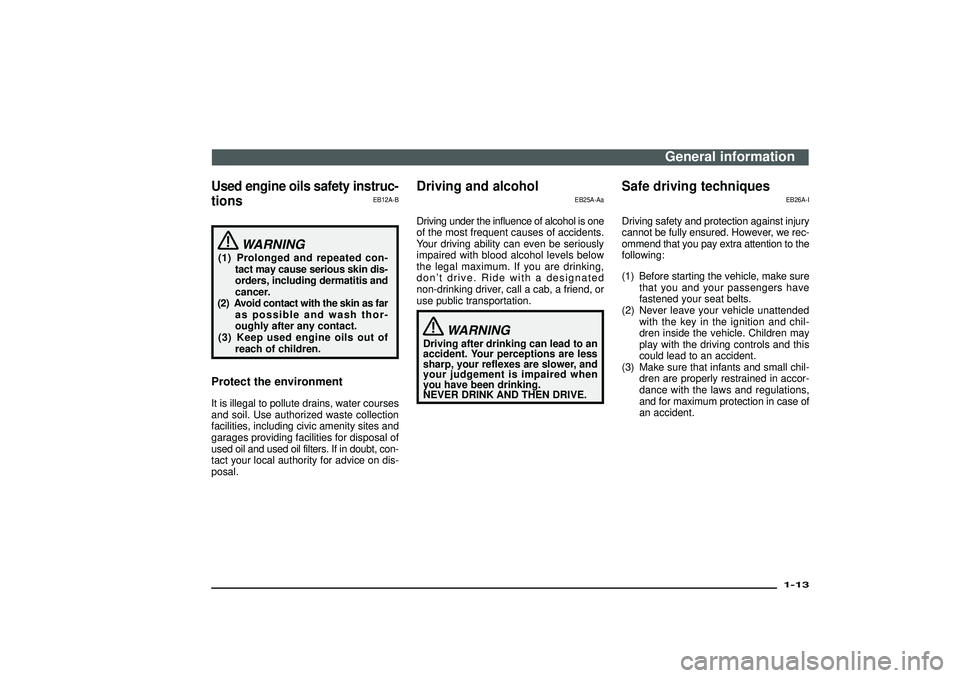
Used engine oils safety instruc-
tions
EB12A-B
WARNING
(1) Prolonged and repeated con-
tact may cause serious skin dis-
orders, including dermatitis and
cancer.
(2) Avoid contact with the skin as far
as possible and wash thor-
oughly after any contact.
(3) Keep used engine oils out of
reach of children.Protect the environmentIt is illegal to pollute drains, water courses
and soil. Use authorized waste collection
facilities, including civic amenity sites and
garages providing facilities for disposal of
used oil and used oil filters. If in doubt, con-
tact your local authority for advice on dis-
posal.
Driving and alcohol
EB25A-Aa
Driving under the influence of alcohol is one
of the most frequent causes of accidents.
Your driving ability can even be seriously
impaired with blood alcohol levels below
the legal maximum. If you are drinking,
don’t drive. Ride with a designated
non-drinking driver, call a cab, a friend, or
use public transportation.
WARNING
Driving after drinking can lead to an
accident. Your perceptions are less
sharp, your reflexes are slower, and
your judgement is impaired when
you have been drinking.
NEVER DRINK AND THEN DRIVE.
Safe driving techniques
EB26A-I
Driving safety and protection against injury
cannot be fully ensured. However, we rec-
ommend that you pay extra attention to the
following:
(1) Before starting the vehicle, make sure
that you and your passengers have
fastened your seat belts.
(2) Never leave your vehicle unattended
with the key in the ignition and chil-
dren inside the vehicle. Children may
play with the driving controls and this
could lead to an accident.
(3) Make sure that infants and small chil-
dren are properly restrained in accor-
dance with the laws and regulations,
and for maximum protection in case of
an accident.
General information
1-13
Div:
Out put date:
Page 98 of 392
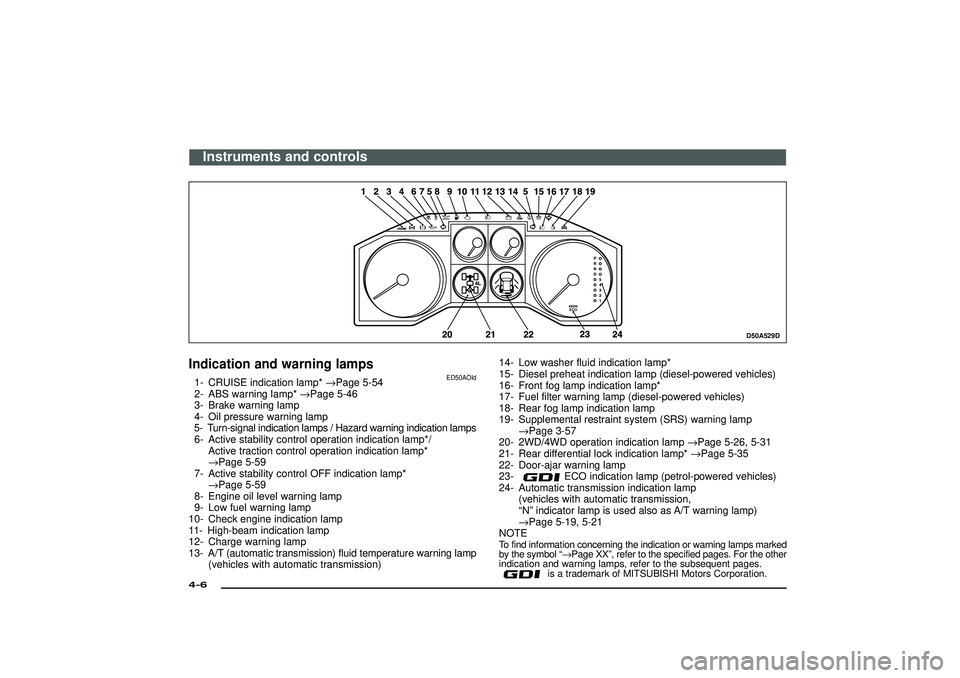
D50A529D
Indication and warning lamps
ED50AOId
1- CRUISE indication lamp*→Page 5-54
2- ABS warning lamp*→Page 5-46
3- Brake warning lamp
4- Oil pressure warning lamp
5- Turn-signal indication lamps / Hazard warning indication lamps
6- Active stability control operation indication lamp*/
Active traction control operation indication lamp*
→Page 5-59
7- Active stability control OFF indication lamp*
→Page 5-59
8- Engine oil level warning lamp
9- Low fuel warning lamp
10- Check engine indication lamp
11- High-beam indication lamp
12- Charge warning lamp
13- A/T (automatic transmission) fluid temperature warning lamp
(vehicles with automatic transmission)14- Low washer fluid indication lamp*
15- Diesel preheat indication lamp (diesel-powered vehicles)
16- Front fog lamp indication lamp*
17- Fuel filter warning lamp (diesel-powered vehicles)
18- Rear fog lamp indication lamp
19- Supplemental restraint system (SRS) warning lamp
→Page 3-57
20- 2WD/4WD operation indication lamp→Page 5-26, 5-31
21- Rear differential lock indication lamp*→Page 5-35
22- Door-ajar warning lamp
23-
ECO indication lamp (petrol-powered vehicles)
24- Automatic transmission indication lamp
(vehicles with automatic transmission,
“N”indicator lamp is used also as A/T warning lamp)
→Page 5-19, 5-21
NOTE
To find information concerning the indication or warning lamps marked
by the symbol“→Page XX”, refer to the specified pages. For the other
indication and warning lamps, refer to the subsequent pages.
is a trademark of MITSUBISHI Motors Corporation.
Instruments and controls
4-6Div:
Out put date:
Page 100 of 392
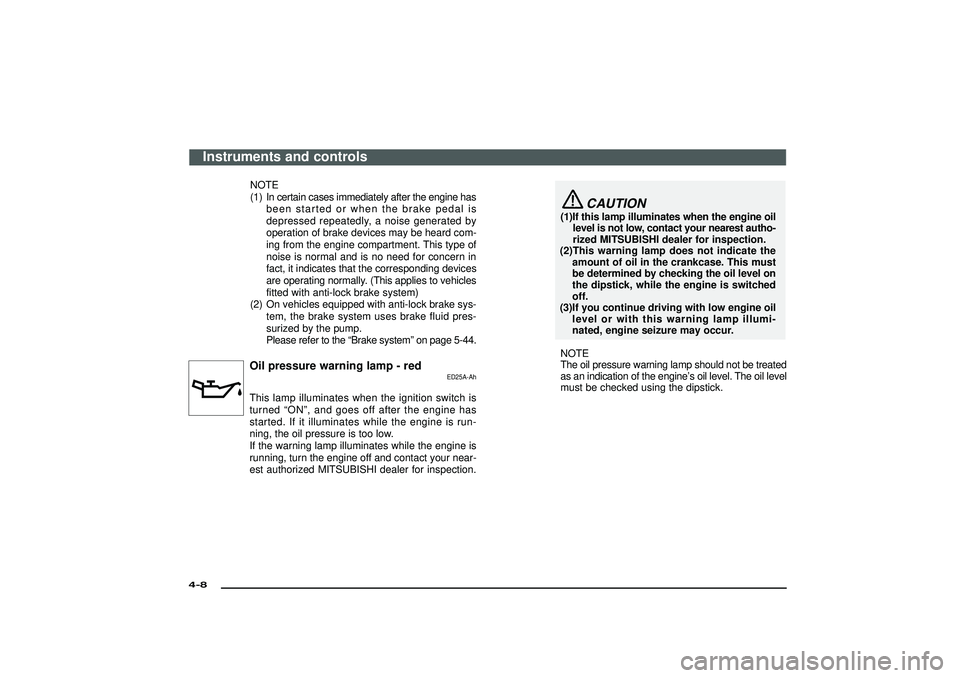
NOTE
(1) In certain cases immediately after the engine hasbeen started or when the brake pedal is
depressed repeatedly, a noise generated by
operation of brake devices may be heard com-
ing from the engine compartment. This type of
noise is normal and is no need for concern in
fact, it indicates that the corresponding devices
are operating normally. (This applies to vehicles
fitted with anti-lock brake system)
(2) On vehicles equipped with anti-lock brake sys-
tem, the brake system uses brake fluid pres-
surized by the pump.
Please refer to the “Brake system ”on page 5-44.Oil pressure warning lamp - red
ED25A-Ah
This lamp illuminates when the ignition switch is
turned “ON ”, and goes off after the engine has
started. If it illuminates while the engine is run-
ning, the oil pressure is too low.
If the warning lamp illuminates while the engine is
running, turn the engine off and contact your near-
est authorized MITSUBISHI dealer for inspection.
CAUTION
(1)If this lamp illuminates when the engine oil level is not low, contact your nearest autho-
rized MITSUBISHI dealer for inspection.
(2)This warning lamp does not indicate the amount of oil in the crankcase. This must
be determined by checking the oil level on
the dipstick, while the engine is switched
off.
(3)If you continue driving with low engine oil level or with this warning lamp illumi-
nated, engine seizure may occur.
NOTE
The oil pressure warning lamp should not be treated
as an indication of the engine ’s oil level. The oil level
must be checked using the dipstick.
Instruments and controls
4-8Div:
Out put date:
Page 101 of 392
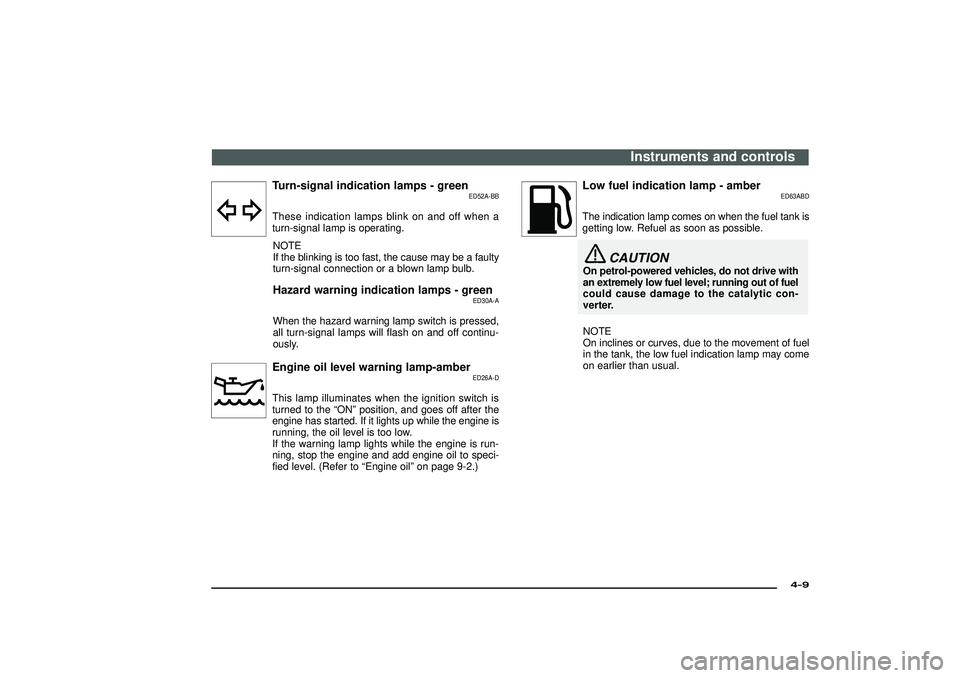
Turn-signal indication lamps - green
ED52A-BB
These indication lamps blink on and off when a
turn-signal lamp is operating.NOTE
If the blinking is too fast, the cause may be a faulty
turn-signal connection or a blown lamp bulb.Hazard warning indication lamps - green
ED30A-A
When the hazard warning lamp switch is pressed,
all turn-signal lamps will flash on and off continu-
ously.Engine oil level warning lamp-amber
ED26A-D
This lamp illuminates when the ignition switch is
turned to the “ON” position, and goes off after theengine has started. If it lights up while the engine is
running, the oil level is too low.
If the warning lamp lights while the engine is run-
ning, stop the engine and add engine oil to speci-
fied level. (Refer to “Engine oil” on page 9-2.)
Low fuel indication lamp - amber
ED63ABD
The indication lamp comes on when the fuel tank is
getting low. Refuel as soon as possible.
CAUTION
On petrol-powered vehicles, do not drive with
an extremely low fuel level; running out of fuel
could cause damage to the catalytic con-
verter.
NOTE
On inclines or curves, due to the movement of fuel
in the tank, the low fuel indication lamp may come
on earlier than usual.
Instruments and controls
4-9
Div:
Out put date:
Page 166 of 392
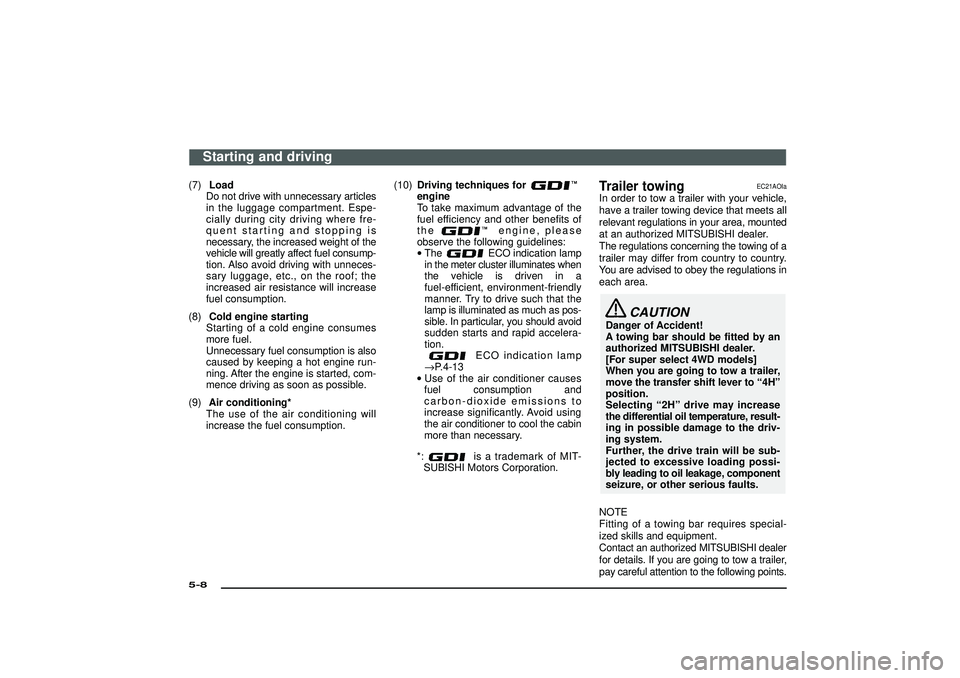
(7)Load
Do not drive with unnecessary articles
in the luggage compartment. Espe-
cially during city driving where fre-
quent starting and stopping is
necessary, the increased weight of the
vehicle will greatly affect fuel consump-
tion. Also avoid driving with unneces-
sary luggage, etc., on the roof; the
increased air resistance will increase
fuel consumption.
(8)Cold engine starting
Starting of a cold engine consumes
more fuel.
Unnecessary fuel consumption is also
caused by keeping a hot engine run-
ning. After the engine is started, com-
mence driving as soon as possible.
(9)Air conditioning*
The use of the air conditioning will
increase the fuel consumption.(10)Driving techniques for
engine
To take maximum advantage of the
fuel efficiency and other benefits of
the
engine, please
observe the following guidelines:
•TheECO indication lamp
in the meter cluster illuminates when
the vehicle is driven in a
fuel-efficient, environment-friendly
manner. Try to drive such that the
lamp is illuminated as much as pos-
sible. In particular, you should avoid
sudden starts and rapid accelera-
tion.
ECO indication lamp
→P.4-13
•Use of the air conditioner causes
fuel consumption and
carbon-dioxide emissions to
increase significantly. Avoid using
the air conditioner to cool the cabin
more than necessary.
*:is a trademark of MIT-
SUBISHI Motors Corporation.
Trailer towing
EC21AOIa
In order to tow a trailer with your vehicle,
have a trailer towing device that meets all
relevant regulations in your area, mounted
at an authorized MITSUBISHI dealer.
The regulations concerning the towing of a
trailer may differ from country to country.
You are advised to obey the regulations in
each area.
CAUTION
Danger of Accident!
A towing bar should be fitted by an
authorized MITSUBISHI dealer.
[For super select 4WD models]
When you are going to tow a trailer,
move the transfer shift lever to“4H”
position.
Selecting“2H”drive may increase
the differential oil temperature, result-
ing in possible damage to the driv-
ing system.
Further, the drive train will be sub-
jected to excessive loading possi-
bly leading to oil leakage, component
seizure, or other serious faults.
NOTE
Fitting of a towing bar requires special-
ized skills and equipment.
Contact an authorized MITSUBISHI dealer
for details. If you are going to tow a trailer,
pay careful attention to the following points.
Starting and driving
5-8Div:
Out put date:
Page 183 of 392

I31D019A
CAUTION
(1) Use 1st gear in the“4L”posi-
tion for very low-speed off-road
driving.
(2) Your vehicle engine should never
be operated with the engine oil
level below the MIN mark on the
dipstick. In rough terrain which
requires four-wheel drive trac-
tion, ensure that the engine oil
level is above the MIN mark on
the dipstick.
Transfer shift lever operation
EI31D-Sb
To shift transfer
case fromTo Procedure
2H 4HThe transfer shift lever can be operated while the vehicle is either moving or sta-
tionary.
In case lever operation is necessary while the vehicle is moving, place the vehicle
in the straight ahead position and depress the clutch pedal to the floor before oper-
ating the lever. 4H 2H
4H 4L
Stop the vehicle, depress the clutch pedal to the floor and operate the transfer shift
lever.
4L 4HNOTE
(1) Shifting of the lever between“2H”↔“4H”should only be made at speeds below 100
km/h (62 mph).
(2) During driving, never attempt to shift from“4H”to“4L”or vice versa.
Starting and driving
5-25
Div:
Out put date:
Page 184 of 392

CAUTION
(1) Do not operate the transfer shift
lever while the rear wheels of the
vehicle are slipping on a snow
covered road.
(2) Do not drive your vehicle in the
“4H”or“4L”position on paved
roads and highway; this would
result in early wear of the tyres,
increased fuel consumption and
possible noise generation.
It may also increase the differ-
ential oil temperature, resulting
in possible damage to the driv-
ing system parts. It is neces-
sary to operate the lever“2H”
position while driving under
these condition.NOTE
(1) When shifting from“2H”to“4H”soon
after driving the vehicle in a cold
weather area, the transmission gear
may make a noise. So try to shift the
gear while the vehicle is stopped.
(2) The 4WD operation indication lamp will
go out momentarily during shifting pro-
cess from“4H”to“4L”or vice versa, as
the shift lever passes through the neu-
tral position.
Be sure to operate the shift lever until
the 2WD/4WD operation indication
lamp illuminates again.
(3) There may be a case that the trans-
fer shift lever feels heavy when it is
moved from“4H”to“2H”with the steer-
ing wheel in turned position. This is nor-
mal and not any indication of trouble.
I31B009A
2WD/4WD operation indication lamp
EI48BXTa
When the ignition switch is in the“ON”
position, the 2WD/4WD operation indica-
tion lamp in the meter indicates the shift-
ing condition. The 2WD/4WD operation
indication lamp comes on at each trans-
fer shift lever position as follows:
Starting and driving
5-26Div:
Out put date:
Page 189 of 392
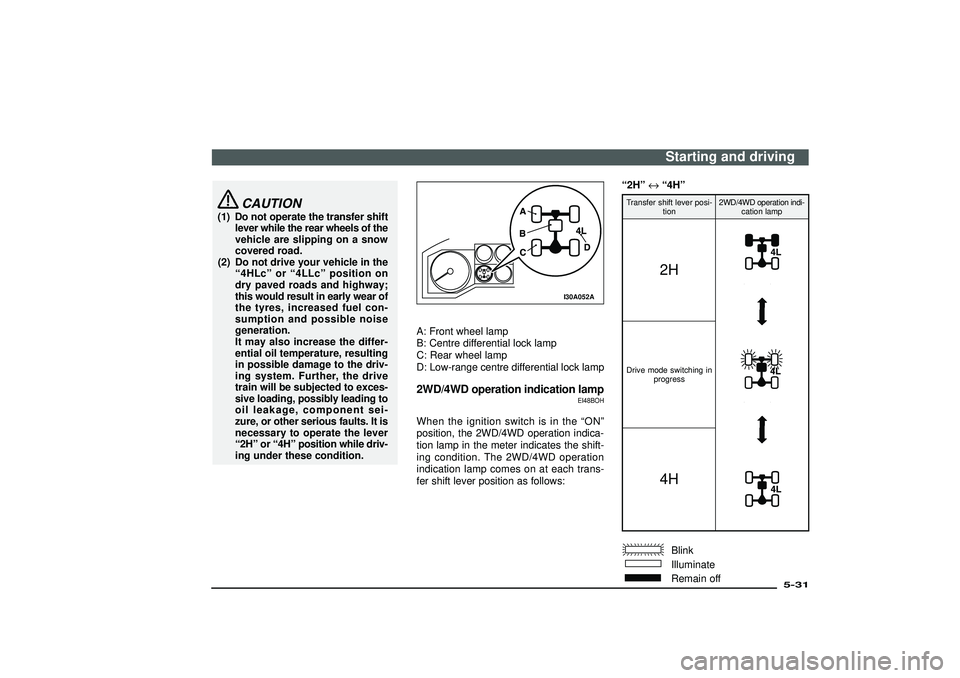
CAUTION
(1) Do not operate the transfer shift
lever while the rear wheels of the
vehicle are slipping on a snow
covered road.
(2) Do not drive your vehicle in the
“4HLc”or“4LLc”position on
dry paved roads and highway;
this would result in early wear of
the tyres, increased fuel con-
sumption and possible noise
generation.
It may also increase the differ-
ential oil temperature, resulting
in possible damage to the driv-
ing system. Further, the drive
train will be subjected to exces-
sive loading, possibly leading to
oil leakage, component sei-
zure, or other serious faults. It is
necessary to operate the lever
“2H”or“4H”position while driv-
ing under these condition.
I30A052A
A: Front wheel lamp
B: Centre differential lock lamp
C: Rear wheel lamp
D: Low-range centre differential lock lamp2WD/4WD operation indication lamp
EI48BOH
When the ignition switch is in the“ON”
position, the 2WD/4WD operation indica-
tion lamp in the meter indicates the shift-
ing condition. The 2WD/4WD operation
indication lamp comes on at each trans-
fer shift lever position as follows:“2H”↔“4H”
Transfer shift lever posi-
tion2WD/4WD operation indi-
cation lamp
2H
Drive mode switching in
progress
4H
BlinkIlluminateRemain offStarting and driving
5-31
Div:
Out put date:
Page 196 of 392
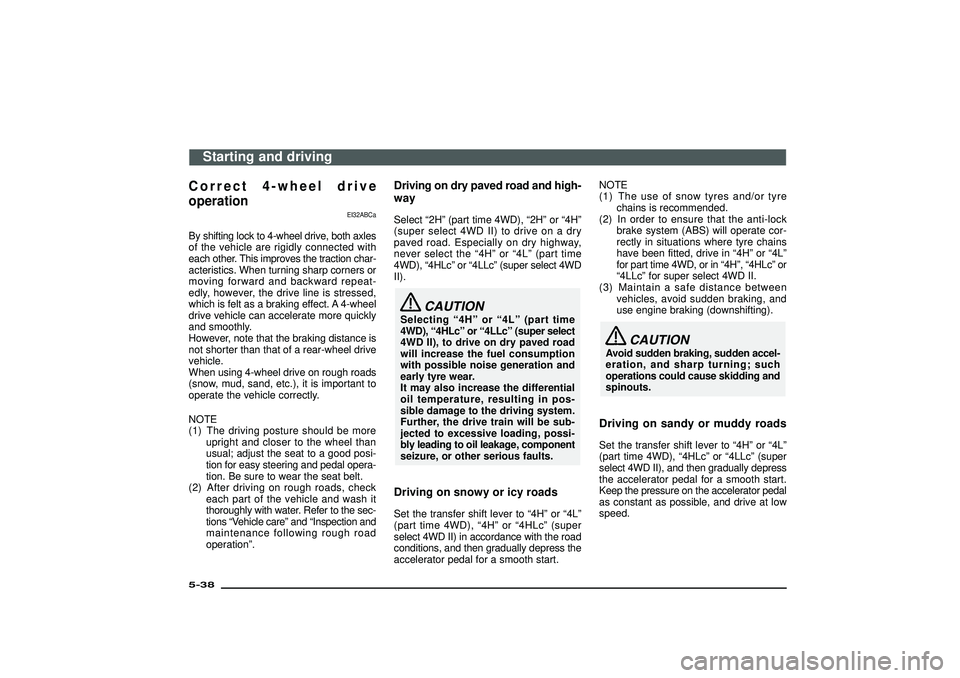
Correct 4-wheel drive
operation
EI32ABCa
By shifting lock to 4-wheel drive, both axles
of the vehicle are rigidly connected with
each other. This improves the traction char-
acteristics. When turning sharp corners or
moving forward and backward repeat-
edly, however, the drive line is stressed,
which is felt as a braking effect. A 4-wheel
drive vehicle can accelerate more quickly
and smoothly.
However, note that the braking distance is
not shorter than that of a rear-wheel drive
vehicle.
When using 4-wheel drive on rough roads
(snow, mud, sand, etc.), it is important to
operate the vehicle correctly.
NOTE
(1) The driving posture should be more
upright and closer to the wheel than
usual; adjust the seat to a good posi-
tion for easy steering and pedal opera-
tion. Be sure to wear the seat belt.
(2) After driving on rough roads, check
each part of the vehicle and wash it
thoroughly with water. Refer to the sec-
tions“Vehicle care”and“Inspection and
maintenance following rough road
operation”.
Driving on dry paved road and high-
waySelect“2H”(part time 4WD),“2H”or“4H”
(super select 4WD II) to drive on a dry
paved road. Especially on dry highway,
never select the“4H”or“4L”(part time
4WD),“4HLc”or“4LLc”(super select 4WD
II).
CAUTION
Selecting“4H”or“4L”(part time
4WD),“4HLc”or“4LLc”(super select
4WD II), to drive on dry paved road
will increase the fuel consumption
with possible noise generation and
early tyre wear.
It may also increase the differential
oil temperature, resulting in pos-
sible damage to the driving system.
Further, the drive train will be sub-
jected to excessive loading, possi-
bly leading to oil leakage, component
seizure, or other serious faults.Driving on snowy or icy roadsSet the transfer shift lever to“4H”or“4L”
(part time 4WD),“4H”or“4HLc”(super
select 4WD II) in accordance with the road
conditions, and then gradually depress the
accelerator pedal for a smooth start.NOTE
(1) The use of snow tyres and/or tyre
chains is recommended.
(2) In order to ensure that the anti-lock
brake system (ABS) will operate cor-
rectly in situations where tyre chains
have been fitted, drive in“4H”or“4L”
for part time 4WD, or in“4H”,“4HLc”or
“4LLc”for super select 4WD II.
(3) Maintain a safe distance between
vehicles, avoid sudden braking, and
use engine braking (downshifting).
CAUTION
Avoid sudden braking, sudden accel-
eration, and sharp turning; such
operations could cause skidding and
spinouts.Driving on sandy or muddy roadsSet the transfer shift lever to“4H”or“4L”
(part time 4WD),“4HLc”or“4LLc”(super
select 4WD II), and then gradually depress
the accelerator pedal for a smooth start.
Keep the pressure on the accelerator pedal
as constant as possible, and drive at low
speed.
Starting and driving
5-38Div:
Out put date:
Page 199 of 392
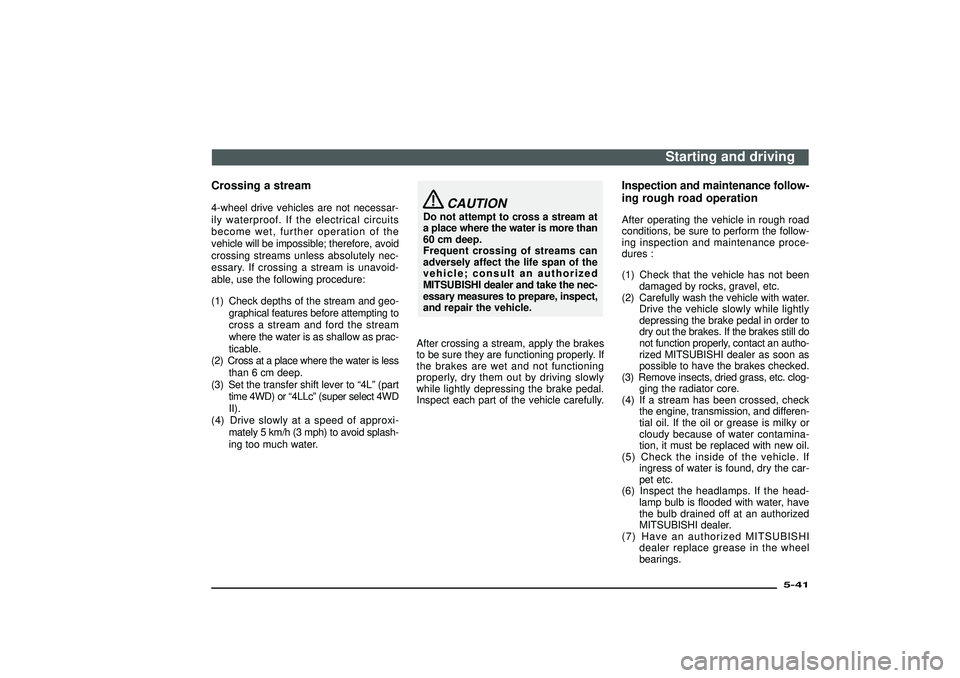
Crossing a stream4-wheel drive vehicles are not necessar-
ily waterproof. If the electrical circuits
become wet, further operation of the
vehicle will be impossible; therefore, avoid
crossing streams unless absolutely nec-
essary. If crossing a stream is unavoid-
able, use the following procedure:
(1) Check depths of the stream and geo-
graphical features before attempting to
cross a stream and ford the stream
where the water is as shallow as prac-
ticable.
(2) Cross at a place where the water is less
than 6 cm deep.
(3) Set the transfer shift lever to“4L”(part
time 4WD) or“4LLc”(super select 4WD
II).
(4) Drive slowly at a speed of approxi-
mately 5 km/h (3 mph) to avoid splash-
ing too much water.
CAUTION
Do not attempt to cross a stream at
a place where the water is more than
60 cm deep.
Frequent crossing of streams can
adversely affect the life span of the
vehicle; consult an authorized
MITSUBISHI dealer and take the nec-
essary measures to prepare, inspect,
and repair the vehicle.
After crossing a stream, apply the brakes
to be sure they are functioning properly. If
the brakes are wet and not functioning
properly, dry them out by driving slowly
while lightly depressing the brake pedal.
Inspect each part of the vehicle carefully.
Inspection and maintenance follow-
ing rough road operationAfter operating the vehicle in rough road
conditions, be sure to perform the follow-
ing inspection and maintenance proce-
dures :
(1) Check that the vehicle has not been
damaged by rocks, gravel, etc.
(2) Carefully wash the vehicle with water.
Drive the vehicle slowly while lightly
depressing the brake pedal in order to
dry out the brakes. If the brakes still do
not function properly, contact an autho-
rized MITSUBISHI dealer as soon as
possible to have the brakes checked.
(3) Remove insects, dried grass, etc. clog-
ging the radiator core.
(4) If a stream has been crossed, check
the engine, transmission, and differen-
tial oil. If the oil or grease is milky or
cloudy because of water contamina-
tion, it must be replaced with new oil.
(5) Check the inside of the vehicle. If
ingress of water is found, dry the car-
pet etc.
(6) Inspect the headlamps. If the head-
lamp bulb is flooded with water, have
the bulb drained off at an authorized
MITSUBISHI dealer.
(7) Have an authorized MITSUBISHI
dealer replace grease in the wheel
bearings.
Starting and driving
5-41
Div:
Out put date: